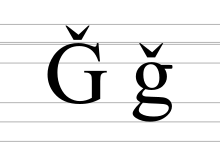G-caron
| G with caron | |
|---|---|
| Ǧ ǧ | |
| ğ, ĝ, ḡ, ġ, ǥ, ǵ, g̃, ģ, ɠ | |
 | |
| Usage | |
| Writing system | Latin script |
| Type | Alphabetic |
| Language of origin | Czechoslovak language |
| In Unicode | U+01E6, U+01E7 |
| History | |
| Development | |
| Time period | 16th century to present |
| Descendants | • Ğ • Ġ |
| Sisters | G Ғ Ґ Ҕ Ӻ چ غ ገ ࠂ ג Ð |
| Variations | ğ, ĝ, ḡ, ġ, ǥ, ǵ, g̃, ģ, ɠ |
| Other | |
| Associated graphs | ğ, ĝ, ḡ, ġ, ǥ, ǵ, g̃, ģ, ɠ |
| Writing direction | Left-to-Right |
⟨Ǧ⟩ (miniscule: ⟨ǧ⟩), called "G with caron", is a letter used in several Latin orthographies.[1]
In the Romany and Skolt Sami languages, it represents the palatalized g [ɟ͡ʝ].
It has also been used in Czech and Slovak orthographies until the middle of the 19th century to represent a voiced velar plosive (IPA: [g]; the English G-sound), whereas a regular ⟨G⟩ stood for a voiced palatal approximant (IPA: [j]; the English Y-sound in).
In the romanization of Pashto, Persian, and South Azeri, ⟨ǧ⟩ is used to represent a voiced velar fricative (IPA: [ɣ]; same as the Arabic letter Ghayn ⟨غ⟩).
In the Berber Latin and Resian alphabets, ⟨ǧ⟩ is pronounced as a voiced postalveolar affricate (IPA: [d͡ʒ]; an English J-sound).
In Lakota, ⟨ǧ⟩ represents a voiced uvular fricative (IPA: [ʁ]; an English R-sound)
In the DIN 31635 Arabic transliteration, it represents the letter Ǧīm ⟨ﺝ⟩.
Computing code
[edit]| Preview | Ǧ | ǧ | ||
|---|---|---|---|---|
| Unicode name | LATIN CAPITAL LETTER G WITH CARON | LATIN SMALL LETTER G WITH CARON | ||
| Encodings | decimal | hex | dec | hex |
| Unicode | 486 | U+01E6 | 487 | U+01E7 |
| UTF-8 | 199 166 | C7 A6 | 199 167 | C7 A7 |
| Numeric character reference | Ǧ |
Ǧ |
ǧ |
ǧ |
References
[edit]- ^ "Unicode Character "Ǧ" (U+01E6)". Compart. Oak Brook, IL: Compart AG. 2021. Retrieved 2024-02-17.
See also
[edit]
